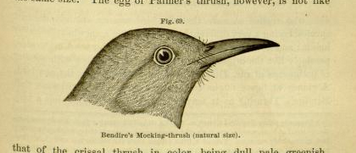On this date in 1872, Charles Bendire took the first skin of the long-tailed desert bird that has been known ever since as the Bendire thrasher.
Bendire sent the bird — a female, preserved by “mummification with carbolic acid” — to Elliott Coues, who, “not having then specially studied these birds,” submitted it to Robert Ridgway, who pronounced the specimen a Palmer curve-billed thrasher. Bendire
replied at once that the bird was an entirely distinct species, laying a very different egg [before shooting the adult, Bendire had collected at least six egg sets of the species in June 1872], and having somewhat dissimilar habits; and he finally settled the case by sending [Coues] a male skin, precisely like the original female specimen, together with several of both sexes of … Palmeri, all alike different from the new bird.
Coues doesn’t quite say “I told you so,” but poor Ridgway doesn’t come out looking any too good in this story. The Smithsonian ornithologist’s misidentification, Coues writes,
puzzled me … but presuming, of course, that he knew his own species better than I did, I felt obliged to rest on what he told me, though I was dissatisfied, and in … the Key, with the specimen before me, refrained from alluding to this (supposed) female of … Palmeri….
Ridgway having missed his chance, it was left to Coues to name the new species, a task he, no doubt gleefully, performed in the pages of The American Naturalist in June 1873, calling it Harporhynchus Bendirei, the Bendire’s Mocking-Thrush.
The skins Bendire sent Coues are now in the US National Museum’s collection, where they lie on their backs with red labels identifying them as the co-types of their species.
Coues treated the two specimens slightly, and tellingly, differently. His formal description is based entirely on the male skin, with just a note at the end that the female is “not distinguishable from the male.” And in incorporating the skins into his private collection, he catalogued the male first, before the female, which had been shot more than three months earlier. It’s an old story and often told, ornithology’s consistent treatment of the male bird as the unmarked category, but rarely do we come across such a glaring example as this one.

Male? Female? Yes.



